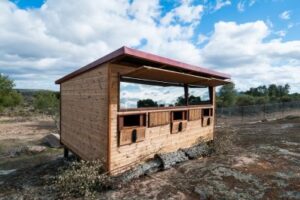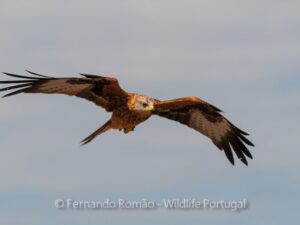
Next stop: Faia Brava Natural Reserve
Today, 3 March 2021, is World Wildlife Day, an opportunity to honour the rich variety of wildlife we can encounter in Portugal. (Note: This is not a sponsored post! We don’t stand to gain anything if you book any of the activities below.)
Located in the ancient Côa Valley, the Faia Brava Reserve, known for birdwatching among other things, is the first and only private protected area of the country – and is less than 1h30 from Casa Beatrix.
The natural environment consists of a mix of gorges, dramatic cliffs, dense forests and meadows all along the Côa River. A visit will give you a glimpse of natural wonders and the possibility to connect with initiatives to rewild and preserve the local ecosystem.

The origin of the project
In the year 2000, the Associação Transumância e Natureza (Transhumance and Nature Association) acquired around 1000 hectares of abandoned farmland to turn it into a reserve. Their main idea: Rewilding one of the most important zones of biodiversity in Portugal.
The objective was to invest in nature and biodiversity conservation, ecological restoration, and forest management. Why Portugal? For a few decades, locals progressively abandoned the farming and rural lifestyle – associated with poverty – to look for work in the cities, hence leading to the loss of traditions such as shepherding.
Faia Brava is actually a pilot project linked to the organisation Rewilding Europe. The Reserve is a hotspot for environmental education through partnerships with schools, but also ecotourism – which is believed to be key to the valorisation of natural assets, and a way to support existing initiatives.
Fauna & flora: What’s to discover in the Reserve?
Natural Environment
Faia Brava is what we call a riparian habitat (a wildlife habitat along a moving water source), composed of the most significant protected patches of cork and holm oaks in the Guarda district. The particularity of the landscape, made of steep slopes, gorges, and cliffs, creates the perfect habitat for rupicolous birds (birds that nest in rocks).
Birdwatching
As a nature conservation project, Faia Brava is all about protecting endangered species by preserving nesting sites and feeding zones of the rare rupicolous birds found in the Côa Valley. If they’re close to extinction today, it is because of the dramatic decline of prey animals, including rabbits, partridges and rock pigeons.
When walking around Faia Brava, you might see the following birds:
- Black Stork (Ciconia nigra)
- Egyptian Vulture (Neophron percnopterus)
- Griffon vulture (Gyps fulvus)
- Golden Eagle (Aquila chrysaetos)
- Bonelli’s Eagle (Aquila fasciata)
- Eagle Owl (Bubo Bubo)
- Alpine Swift (Apus melba)
Here is a more complete list.
Indigenous wildlife
Since the Reserve’s opening, the staff observed an increase in the population of “garranos”, endangered mountain ponies native to the Iberian region, and the “maronesas”, a traditional Portuguese breed of mountain cattle.

Photo credit: JUAN CARLOS MÚÑOZ / REWILDING EUROPE (https://rewildingeurope.com/blog/faia-brava-as-a-showcase-of-rewilding/)
As native grazers, their role in the local ecosystem is to help control and reduce the amount of young forest and scrub, one of the leading causes of wildfires. Cleaning the land also makes space for other species to grow naturally, directly promoting biodiversity, recovering the native forest, and reintroducing species like the roe deer or Iberian ibex (the Iberian wild goat!), and hopefully, one day, the Iberian Lynx.
Faia Brava is also the home of many different species of small mammals, reptiles, amphibians and insects – including the Spiny-footed Lizard, the Moorish Gecko, or the Ladder Snake.
The presence of smaller animals, such as rabbits and hares is controlled, as they are an essential source of prey for birds, mongoose, civets, and wild cats.
Even the dozen traditional buildings, locally known as the “pombais” (dovecotes), are used for conservation purposes by becoming shelters for rock pigeons, the prey of the endangered Bonelli’s Eagle. By ensuring the wellbeing of the pigeons, eagles are indirectly taken care of.
What to do in Faia Brava?
Guided visit
The European Safari Company organizes tours with a twist. They make you experience the wild side of the area – safari style. Bonus: 5% of each booking goes to Rewilding Europe.
Citadelhe Rupestre is a rural tourism company that works as a reception centre for Faia Brava, proposing certified guides and safari drives.
A night in the wild
Star Camp is a unique safari sleeping experience in the Portuguese wilderness, and one of the only accommodations in the Reserve. Nature lovers will appreciate the lodges’ simplicity and its furnishings with all necessary amenities including toilets, a shower, and even Wi-Fi.
Portuguese gastronomy in a natural setting
That’s the concept of Miles Away, a travel agency offering foodie experiences for tourists. Quirky spots in nature while discovering Portuguese food along with a selection of local wine from the famous Douro valley – yes please!
They also organise tailored programs for an afternoon or a few days, including guided visits to nearby sites, local winemakers, and natural wonders. Recently, they launched Fly Camp: Open-air accommodations in the wild, with breath-taking views of the valley. Pretty special!
A day of activities with Wildlife Portugal
Supported by Rewilding Europe, Fernando Romão from Wildlife Portugal is a guide specialized in outdoor, adventure and nature interpretation. He organises unique tours, including birdwatching, 4×4, hiking and nature excursions, and last but not least vulture hides (see photo below) which are designed to allow proximity while avoiding any invasive impact on wildlife.


The Grand Route of Côa Valley
Faia Brava is included in the GR45, the Côa Valley Grand Route, stretching across more than 200km where it’s possible to walk, cycle or horseride.
The trails of the forgotten shepherds: The “Trilho dos Biólogos”
The “Biologists’ Trail” is a rather short walk, only 2 km that will take around 2 hours by foot according to the Reserve’s website. It goes through the Reserve, giving the possibility to observe various animals and birds along the way. It also passes by the Miradouro da Milhoteira Trata, where you can enjoy a breath-taking view of the valley. Back in the days, this trail was used by shepherds.
Exploring the surroundings
Near the Reserve, you’ll find the medieval town of Castelo Rodrigo, which offers plenty of historical sites to visit.
The rich heritage of the Côa Valley doesn’t stop here. Classified as a UNESCO World Heritage Site, the open-air archaeological park displays rock art and engraved outcrops dating back from the Paleolithic era, and vineyards in the region offer stunning settings for tastings and gastronomic experiences.
To organise a visit to Faia Brava Reserve, you must book ahead of time. We recommend sending an email to geral[AT]atnatureza.org with details such as the desired date of the visit and how many people will be going. This was confirmed late February 2021 by the Reserve as the best approach.



